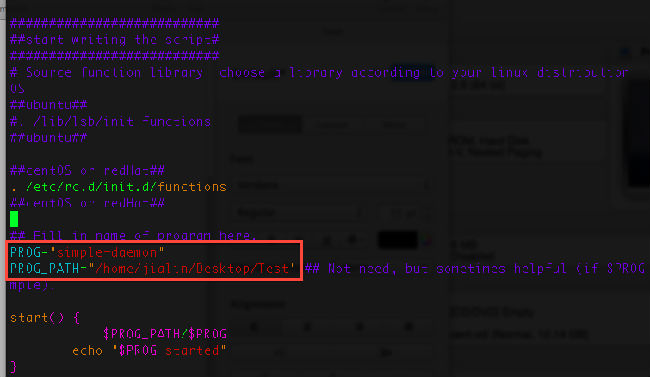守护进程daemon的创建和使用
2013-12-11 00:00
429 查看
摘要: 《Unix高级环境编程》中介绍了怎么写一个daemon的基本步骤,但是没有讲到在怎么在系统中使用(即像apache那样开机启动,关机停止),在这里写了一个简单的例子供大家参考。
daemon的创建和使用
创建守护进的关键步骤:
step 1.创建子进程,父进程退出
step 2.在子进程中创建新会话
step 3.改变当前目录为根目录
step 4.重设文件权限掩码
step 5.关闭文件描述符
以下是一个简单的daemon例子
代码:
附1
附2
将file.c编译成名为 simple-daemon

然后在脚本daemon-script中编辑程序的名字和路径

将脚本daemon-script 复制到/etc/init.d/目录下
然后执行 chkconfig - -add daemon-script

可以看到chkconfig默认在run level 2 3 4 5下通过deamon-script脚本来启动指定的程序simple-daemon,在run level 0 1 6下通过deamon-script脚本来关闭指定的程序simple-daemon。
也可以在terminal中以管理员的身份执行
service daemon-script start //启动,当然系统默认是开启的
service daemon-script stop //停止
service daemon-script restart //重启
附1:
附2:
daemon的创建和使用
创建守护进的关键步骤:
step 1.创建子进程,父进程退出
step 2.在子进程中创建新会话
step 3.改变当前目录为根目录
step 4.重设文件权限掩码
step 5.关闭文件描述符
以下是一个简单的daemon例子
代码:
附1
附2
将file.c编译成名为 simple-daemon

然后在脚本daemon-script中编辑程序的名字和路径

将脚本daemon-script 复制到/etc/init.d/目录下
然后执行 chkconfig - -add daemon-script

可以看到chkconfig默认在run level 2 3 4 5下通过deamon-script脚本来启动指定的程序simple-daemon,在run level 0 1 6下通过deamon-script脚本来关闭指定的程序simple-daemon。
也可以在terminal中以管理员的身份执行
service daemon-script start //启动,当然系统默认是开启的
service daemon-script stop //停止
service daemon-script restart //重启
附1:
//this app write the system time to testFile every two seconds
//这个程序将会每间隔2秒在文件中写入系统时间(date),你可以在下面 arr 中定义文件的位置
// file.c
//
// Created by Jialin Wu on 11/12/13.
//
#include <stdio.h>
#include <stdlib.h>
#include <time.h>
#include <fcntl.h>
void daemonize(void) {
pid_t pid;
/*
* Become a session leader to lose controlling TTY.
*创建子进程,父进程退出
*/
if ((pid = fork()) < 0) {
perror("fork");
exit(1);
} else if (pid != 0) /* parent */
exit(0);
//在子进程中创建新会话
setsid();
/*改变当前目录为/目录
*如果程序要与数据库有关,可能会在更改当前目录后出不现莫名奇妙的错误,可尝试不更改当前目录
* Change the current working directory to the root.
* if you are using database just ignore this and comment them.
*/
/*if (chdir("/") < 0) {
perror("chdir");
exit(1);
}
*/
//重设文件权限掩码
umask(0);
/*关闭文件描述符
*
*/
close(0);
close(1);
close(2);
//Attach file descriptors 0, 1, and 2 to /dev/null.可选
open("/dev/null", O_RDWR);
dup2(0, 1);
dup2(0, 2);
}
int main(int argc, const char *argv[])
{
int file;
struct tm* newtime;
time_t ttime;
daemonize(); //这个functione的作用就是使之成为daemon
while(1){
ttime=time(NULL);
newtime = localtime(&ttime);
char* arr= "/Users/jialin/Desktop/testFile"; //you might change the file path you want
file = open(arr,O_WRONLY|O_CREAT);
system("date >> /Users/jialin/Desktop/testFile");
sleep(2);
close(file);
}
return 0;
}附2:
#!/bin/bash
### BEGIN INIT INFO
#
# Default-Start: 2 3 4 5
# Default-Stop: 0 1 6
# Description: This file should be used to construct scripts to be placed in /etc/init.d.
#
# to use make this script work, for example:
# if you are using ubuntu:
# update-rc.d scriptName defaults 20 80
# for more information find update-rc.d
# if you are using centOS or redHat:
# chkconfig --add scriptName
# defaults are 2345 on and 016 off so you can ignore the following steps if not try the followings:
# chkconfig --level 2345 scriptName on
# chkconfig --level 016 scriptNmae off
# for more information find chkconfig
### END INIT INFO
###########################
#start writing the script#
###########################
# Source function library choose a library according to your linux distribution and now I'm using centOS
#选择function library ,不同的Linux发行版function library 的位置不不相同
##ubuntu##
#. /lib/lsb/init-functions 如果在是ubuntu下的,把这句去掉注释,把下面centOS 加注释
##ubuntu##
##centOS or redHat## 我现在用的是centOS
. /etc/rc.d/init.d/functions
##centOS or redHat##
## Fill in name of program here.
PROG="guetoj_scheduler"
PROG_PATH="/home/jialin/judger" ## Not need, but sometimes helpful (if $PROG resides in /opt for example).
start() {
$PROG_PATH/$PROG
echo "$PROG started"
}
stop() {
echo "begin stop"
killall $PROG
echo "$PROG stopped"
}
# Check to see if we are running as root first.
if [ "$(id -u)" != "0" ]; then
echo "This script must be run as root" 1>&2
exit 1
fi
case "$1" in
start)
start
exit 0
;;
stop)
stop
exit 0
;;
reload|restart|force-reload)
stop
start
exit 0
;;
**)
echo "Usage: $0 {start|stop|reload}" 1>&2
exit 1
;;
esac
相关文章推荐
- linux系统编程之进程(八):守护进程详解及创建,daemon()使用
- linux系统编程之进程(八):守护进程详解及创建,daemon()使用
- 守护进程daemon的创建和使用
- linux系统编程之进程(八):守护进程详解及创建,daemon()使用
- linux系统编程之进程(八):守护进程详解及创建,daemon()使用
- linux系统编程之进程(八):守护进程详解及创建,daemon()使用
- 守护进程详解及创建,daemon()使用(转载)
- 守护进程详解及创建,daemon()使用
- linux系统编程之进程(八):守护进程详解及创建,daemon()使用
- linux系统编程之进程(八):守护进程详解及创建,daemon()使用
- 守护进程daemon的创建和使用
- linux系统编程之进程(八):守护进程详解及创建,daemon()使用
- 守护进程详解及创建,daemon()使用
- linux系统编程之进程(八):守护进程详解及创建,daemon()使用
- linux系统编程之进程(八):守护进程详解及创建,daemon()使用
- linux系统编程之进程(八):守护进程详解及创建,daemon()使用
- linux系统编程:守护进程详解及创建,daemon()使用
- linux守护进程详解及创建,daemon()使用
- 在创建守护进程时优先选用系统调用daemon()
- Linux环境下,使用PHP创建一个守护进程
